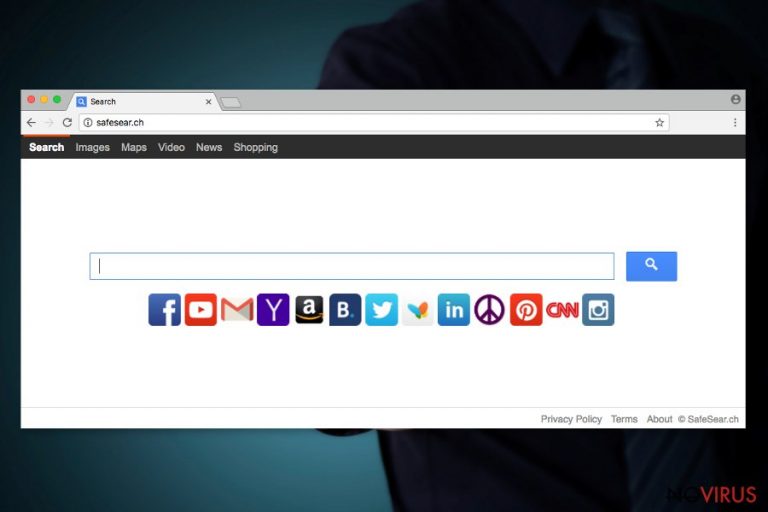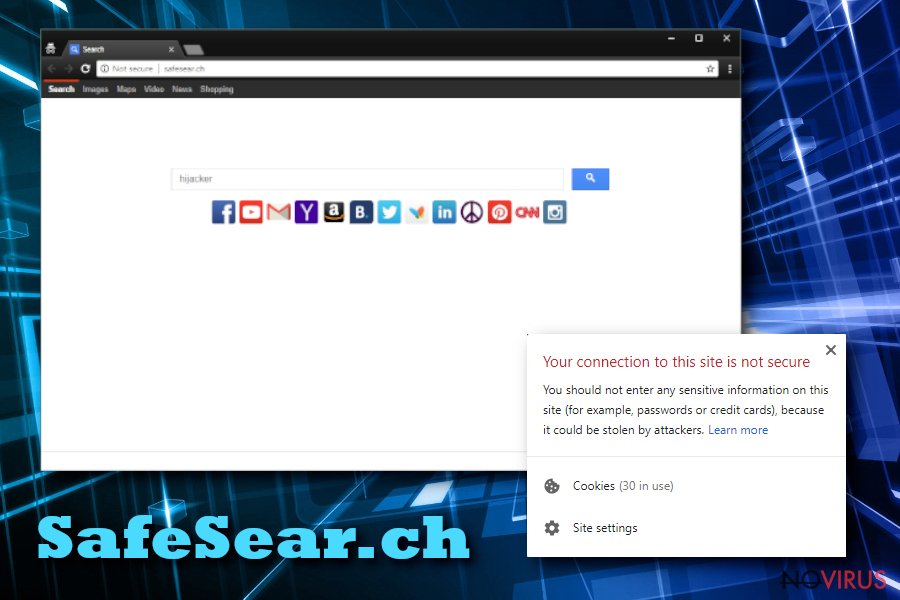Remove SafeSearch (Uninstall Instructions) - Jan 2020 updated
SafeSearch Removal Guide
Description of SafeSearch
Important information about SafeSearch virus

SafeSearch virus has been targeting web browsers for almost two years. It seems that this annoying browser hijacker is not willing to give up. AVSoftware designed this program as a reliable and safe search engine that filters malicious websites. However, if you read the Privacy Policy carefully, you will find out that developers reveal that some of the provided links might lead to questionable sites that may contain dangerous viruses.
Bear in mind that if you encounter a virus, creators of SafeSearch.ch will not take any responsibility for your damage. It’s only your fault that you end up on malicious site after clicking on a dangerous link in the search results. Indeed, hijacker delivers modified search results, so they may differ from results provided by Google or other reputable search engines. However, virus prevents users from accessing reliable search engines.
To know that your computer was infected is really simple. You either notice changed homepage or default search engine, or face unexpected redirects to SafeSearch. Besides, hijacker won’t let you restore previous settings. Once it gets inside it takes full control of all popular web browsers. Don’t let virus have fun on your browsers and remove SafeSearch as soon as it appears on the screen. FortectIntego might help you a lot in the elimination process.

Browser hijacker spreads bundled with various free programs and after infiltration stays resident in background. It might modify registry settings in order to stay longer on the PC. It came inside to deliver commercial content. Developers of SafeSearch virus wants you to visit various promotional websites, so they include sponsored links into search results and initiate unexpected redirects. You may end up on a strange website when you start typing an address in URL bar or when you click on another link.
Beware that after one unlucky SafeSearch redirect you might catch unpleasant computer infection. Hijacker has another feature that worries us – it may collect information about users. In their Privacy Policy developers state that they do not collect personally identifiable or private information and do not share any gathered information with third-parties.
However, they record information related to your browsing activity: IP address, cookie information, browsing history, etc. Indeed, it seems like not a big problem that someone has access to your browsing history, but don’t forget that this program entered your computer without your knowledge. So, you cannot be sure what hidden purposes the developers have. Initiate SafeSearch removal and protect yourself from all possible threats.

How does browser hijacker spread?
If you download software from unknown websites or using file-sharing services, you might face SafeSearch hijack as well. This potentially unwanted program spreads bundled with regular software and sneaks inside the system when users choose ‘Basic’ or ‘Quick’ installation mode. Using this setup, you let install PUPs without even realising it. Bear in mind that installers do not adequately inform about additional programs.
Therefore, you have always monitor installation process and ‘unpack’ software by choose ‘Advanced’ or ‘Custom’ installation mode. It allows opting the list of optional installs and declining them. If you see the list, but you cannot unmark them, you should quit installation and look for another program.
Besides, you should read EULA, Terms and Agreements, Privacy Policy or other provided documents. There you can find important information that will help to make a decision if a program is worth installing.

SafeSearch removal procedure
SafeSearch.ch virus causes lots of unwanted and disturbing activities. There’s no need to deal with redirects, pop-ups, and corrupted search results. You can easily get rid of the infection and get back to normal browsing. Besides, browser hijacker might install various third-party tools and application that might reduce your computer’s speed and even try to steal your private information. Do not risk and remove SafeSearch!
At the end of the article, you will find a step-by-step guide how to eliminate virus manually. Follow these steps carefully, because it’s important to delete all virus-related components in order to avoid another hijack. However, you can initiate automatic SafeSearch removal and dedicate this job for a professional program.
You may remove virus damage with a help of FortectIntego. SpyHunter 5Combo Cleaner and Malwarebytes are recommended to detect potentially unwanted programs and viruses with all their files and registry entries that are related to them.
Getting rid of SafeSearch. Follow these steps
Uninstall SafeSearch in Windows systems
SafeSearch removal requires uninstalling all programs that are related to this browser hijacker. Look for these programs and remove them: SafeSearch, SafeSearch Toolbar, SafeSear.ch, Trovi, Music Search App and Genieo. If you keep one of these programs, you might encounter another virus attack.
Terminate suspicious programs from Windows 10/8 machines by following these instructions:
- Type Control Panel into Windows search and once the result shows up hit Enter.
- Under Programs, choose Uninstall a program.

- Find components related to suspicious programs.
- Right-click on the application and select Uninstall.
- Click Yes when User Account Control shows up.

- Wait for the process of uninstallation to be done and click OK.
Windows 7/XP instructions:
- Click on Windows Start and go to Control Panel on the right pane.
- Choose Add/Remove Programs.

- Select Uninstall a program under Programs in Control Panel.
- Click once on the unwanted application.
- Click Uninstall/Change at the top.
- Confirm with Yes.
- Click OK and finish the removal.
Uninstall SafeSearch in Mac OS X system
-
Users who use OS X should click on Go button, which can be found at the top left corner of the screen and select Applications.

-
Wait until you see Applications folder and look for SafeSearch or any other suspicious programs on it. Now right click on every of such entries and select Move to Trash.

Delete SafeSearch from Microsoft Edge
SafeSearch virus might have installed various extensions that might have malicious features. Get rid of all of them!
Delete suspicious extensions from MS Edge:
- Go to the Menu by clicking on the three horizontal dots at the top-right.
- Then pick Extensions.

- Choose the unwanted add-ons on the list and click on the Gear icon.
- Click on Uninstall at the bottom.
Clear cookies and other data:
- Click on the Menu and from the context menu select Privacy & security.
- Under Clear browsing data, select Choose what to clear.

- Choose everything except passwords, and click on Clear.
Alter new tab and homepage settings:
- Click the menu icon and choose Settings.
- Then find On startup section.
- Click Disable if you found any suspicious domain.
Reset MS Edge fully:
- Click on the keyboard Ctrl + Shift + Esc to open Task Manager.
- Choose More details arrow at the bottom.
- Go to Details tab.

- Now scroll down and locate every entry with Microsoft Edge name in it.
- Right-click on each of them and select End Task to stop MS Edge from running.
When none of the above solves the issue, you might need an advanced Edge reset method, but you need to backup your data before proceeding.
- Find the following folder on the PC: C:\\Users\\%username%\\AppData\\Local\\Packages\\Microsoft.MicrosoftEdge_8wekyb3d8bbwe.
- Press Ctrl + A on your keyboard to select all folders.

- Right-click on the selection and choose Delete
- Right-click on the Start button and pick Windows PowerShell (Admin).

- Copy and paste the following command, and then press Enter:
Get-AppXPackage -AllUsers -Name Microsoft.MicrosoftEdge | Foreach {Add-AppxPackage -DisableDevelopmentMode -Register “$($_.InstallLocation)\\AppXManifest.xml” -Verbose
Instructions for Chromium-based Edge
Delete extensions:
- Open Edge and click Settings.
- Then find Extensions.

- Delete unwanted extensions with the Remove.
Clear cache and site data:
- Click on Menu and then Settings.
- Find Privacy and services.
- Locate Clear browsing data, then click Choose what to clear.

- Time range.
- Click All time.
- Select Clear now.
Reset Chromium-based MS Edge browser fully:
- Go to Settings.
- On the left side, choose Reset settings.

- Select Restore settings to their default values.
- Click Reset.
Delete SafeSearch from Mozilla Firefox (FF)
Look through the list of extensions. There you might find various toolbars and add-ons that are related to SafeSearch virus. Uninstall them all.
Remove suspicious Firefox extensions:
- Open Mozilla Firefox browser and click on the three horizontal lines at the top-right to open the menu.
- Select Add-ons in the context menu.

- Choose plugins that are creating issues and select Remove.
Reset the homepage on the browser:
- Click three horizontal lines at the top right corner.
- This time select Options.
- Under Home section, enter your preferred site for the homepage that will open every time you launch Mozilla Firefox.
Clear cookies and site data:
- Click Menu and pick Options.
- Find the Privacy & Security section.
- Scroll down to choose Cookies and Site Data.

- Click on Clear Data… option.
- Click Cookies and Site Data, Cached Web Content and press Clear.
Reset Mozilla Firefox:
If none of the steps above helped you, reset Mozilla Firefox as follows:
- Open Mozilla Firefox and go to the menu.
- Click Help and then choose Troubleshooting Information.

- Locate Give Firefox a tune-up section, click on Refresh Firefox…
- Confirm the action by pressing on Refresh Firefox on the pop-up.

Chrome browser reset
Check the list of extension and look for these entries: SafeSearch, SafeSearch Toolbar, SafeSear.ch, Trovi, Music Search App and Genieo. These add-ons might are related to SafeSearch virus, so you have to uninstall them.
Find and remove suspicious extensions from Google Chrome:
- In Google Chrome, open the Menu by clicking three vertical dots at the top-right corner.
- Select More tools > Extensions.
- Once the window opens, you will see all the installed extensions.
- Find any suspicious add-ons related to any PUP.
- Uninstall them by clicking Remove.

Clear cache and web data from Chrome:
- Click the Menu and select Settings.
- Find Privacy and security section.
- Choose Clear browsing data.
- Select Browsing history.
- Cookies and other site data, also Cached images and files.
- Click Clear data.

Alter settings of the homepage:
- Go to the menu and choose Settings.
- Find odd entries in the On startup section.
- Click on Open a specific or set of pages.
- Then click on three dots and look for the Remove option.
Reset Google Chrome fully:
You might need to reset Google Chrome and properly eliminate all the unwanted components:
- Go to Chrome Settings.
- Once there, scroll down to expand Advanced section.
- Scroll down to choose Reset and clean up.
- Click Restore settings to their original defaults.
- Click Reset settings again.

Delete SafeSearch from Safari
Get rid of questionable extensions from Safari:
- Click Safari.
- Then go to Preferences…

- Choose Extensions on the menu.
- Select the unwanted extension and then pick Uninstall.
Clear cookies from Safari:
- Click Safari.
- Choose Clear History…

- From the drop-down menu under Clear, find and pick all history.
- Confirm with Clear History.
Reset Safari fully:
- Click Safari and then Preferences…
- Choose the Advanced tab.
- Tick the Show Develop menu in the menu bar.
- From the menu bar, click Develop.

- Then select Empty Caches.
Even if you have completed all the steps above, we still strongly recommend you to scan your computer system with a powerful anti-malware software. It is advisable to do that because an automatic malware removal tool can detect and delete all remains of SafeSearch, for instance, its registry keys. The anti-malware program can help you to easily detect and eliminate possibly dangerous software and malicious viruses in an easy way. You can use any of our top-rated malware removal programs: FortectIntego, SpyHunter 5Combo Cleaner or Malwarebytes.
How to prevent from getting browser hijackers
Prevent the government from spying on you
As there is a growing debate in government about collecting users' data and spying on citizens, you should take a closer look at this issue and find out what shady ways of gathering information can be used to collect information about you. You need to browse anonymously if you want to avoid any government-initiated spying and tracking of information.
You can enjoy secure internet browsing and minimize the risk of intrusion into your system if you use Private Internet Access VPN program. This VPN application creates a virtual private network and provides access to the required data without any content restrictions.
Control government and other third party access to your data and ensure safe web browsing. Even if you do not engage in illegal activities and trust your ISP, we recommend being careful about your security. You should take extra precautions and start using a VPN program.
Reduce the threat of viruses by backing up your data
Due to their own careless behavior, computer users can suffer various losses caused by cyber infections. Viruses can affect the functionality of the software or directly corrupt data on your system by encrypting it. These problems can disrupt the system and cause you to lose personal data permanently. There is no such threat if you have the latest backups, as you can easily recover lost data and get back to work.
It is recommended to update the backups in parallel each time the system is modified. This way, you will be able to access the latest saved data after an unexpected virus attack or system failure. By having the latest copies of important documents and projects, you will avoid serious inconveniences. File backups are especially useful if malware attacks your system unexpectedly. We recommend using the Data Recovery Pro program to restore the system.


